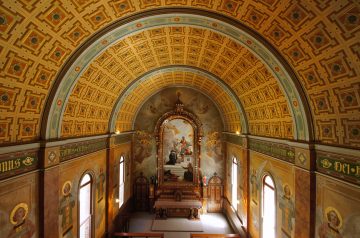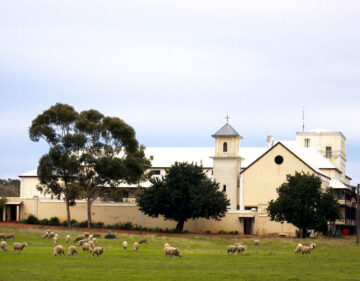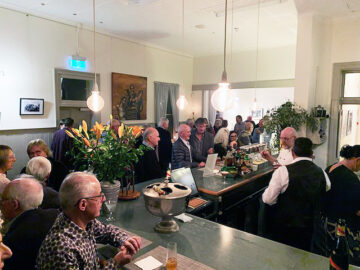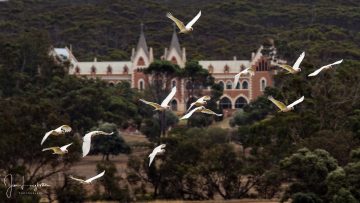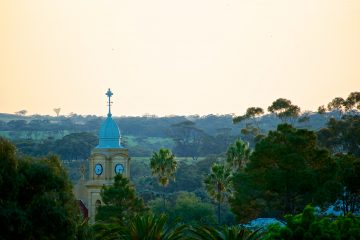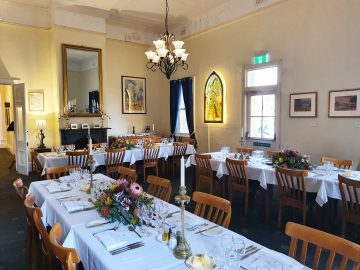Thursday, 17th November 2022
A Volunteer's Retirement Adventure!
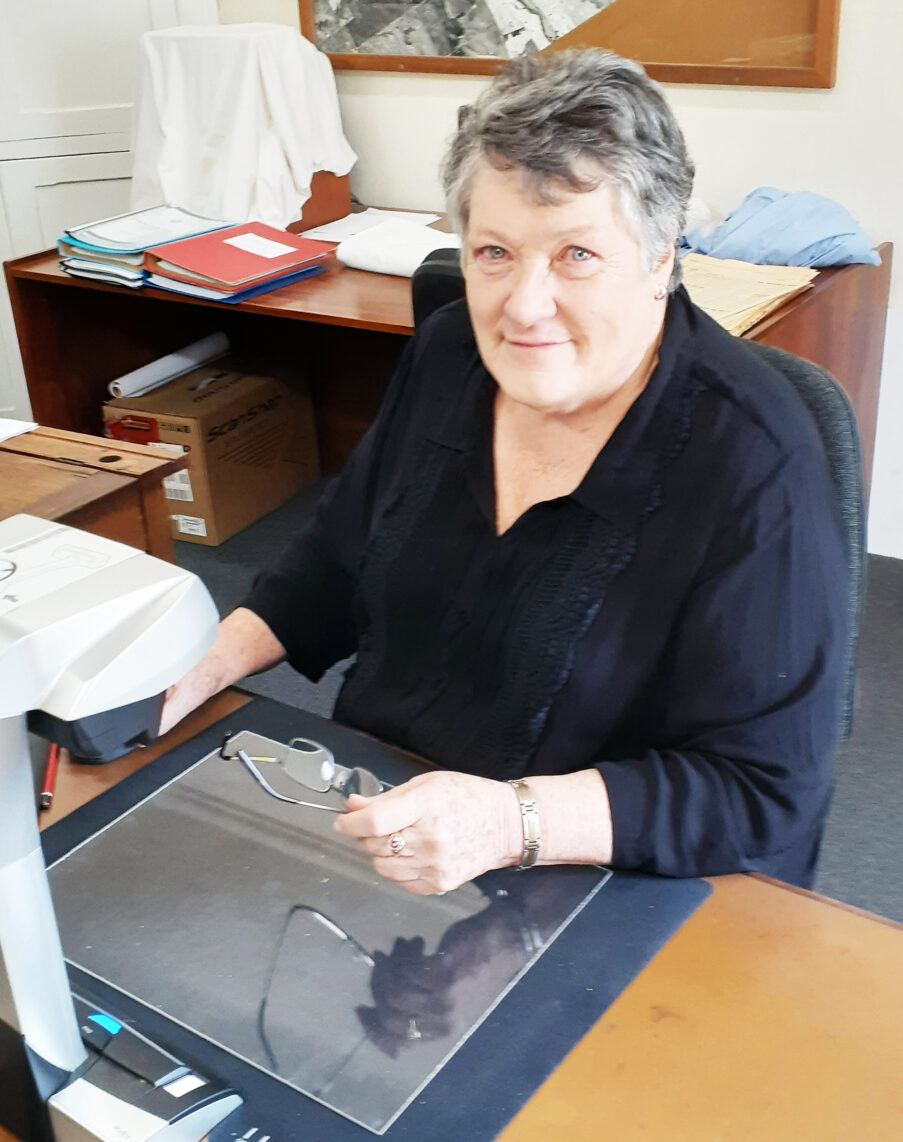
by Vida Whale
I first stumbled across New Norcia ten years ago when travelling with my sister-in-law to Leinster, not long after coming from New Zealand to live in Perth. A totally unexpected, exotic township we thought. We were just too early for coffee so carried on. I came back twice in later years to do the tour with Kiwi friends as I found the place so interesting. Who could anticipate that a Retreat Weekend gift from the family for my 70th birthday would open the doors to a fascinating three years of full-time volunteering in the archives! I had spent the past six years wandering around Australia with my caravan, worked with BlazeAid in Waroona for three months after the fires, and spent some time house-sitting between Waroona and Esperance. Something different to try I thought.
I came to New Norcia for eight weeks over the period of a year to begin with. Peter Hocking, the archivist, gave me the task of continuing the scanning of Salvado’s correspondence from 1845 to 1900. They have been translated and summarised. I had to check that the letters’ dates and numbers matched these summaries. How hard can that be? I quickly learned a lesson about being very meticulous! After the eight weeks, I calculated that if I had five months of uninterrupted time here, I could finish the thousands of letters, so Peter suggested I put a proposal to the Abbot, which was accepted. I was given a house with room to park the caravan and in May 2019 started full time volunteering.
Peter, in his wisdom, felt that scanning letters all day for months could get rather monotonous so he gave me other tasks to break it up. There are 30,000+ photos in boxes. Most had been scanned, described and numbered but needed to be checked with the computer records and sorted into envelopes in the boxes so they were easier to find. I needed to make sure they all had descriptions, no spelling mistakes, and that all people and cars were named where possible. Luckily Peter is an absolute whizz at recognising old cars, and Geraldine Byrne had spent many years naming the people she knew.
The five months passed quickly and there was no mention of me leaving. I finished scanning all the letters at the beginning of October with a huge feeling of satisfaction. I did spend a few more weeks going back through every one to correct my mistakes, and some of the summaries needed minor corrections as well. I found some letters that had not been summarised, so I did the English ones, and put the scans of all the others in a folder to be done by Spanish or Italian experts. One hopes these historical treasures can now stay safely in the vault and not be handled again.
Another very important task was to scan all the records of the Aboriginal children, and to make sure that all the students’ records were in individual folders so they could be accessed easily. We went through every relevant box and took out every bit of paper relating to every child! It was a huge job, but now there is a database on computer, and full filing cabinets.
Fr David has spent many years working on Salvado’s sixteen diaries. They have all been translated from Spanish and he asked for my help with the last three. He is making a very detailed index of every person mentioned in the diaries, and every occupation they had. What an interesting job that turned out to be but once again a huge learning curve for me as I had not worked in Word with ‘headings’ and ‘small caps’ to say nothing of the many variations of the spellings of Aboriginal names, whom they married, which child belonged to which family, as well as the many extended farming families in the districts, people passing through New Norcia, and all the monks who worked here as mentioned by Salvado in these diaries! Much detective work was required, but Fr David, who is well into his 80’s, has an incredible memory, and a great knowledge of all these people.
The family of Charles Austin Gardner (pre–WW2 Western Australian Government botanist) has given New Norcia a collection of his personal effects and letters, which I catalogued. There is a large book in which he drew small and beautifully detailed sketches of plants, some delightful letters to and from his sister, interesting little Victorian glass slides with comic paintings on them, toiletry items, surveying instruments, and an unusual small curved leather container. Fortunately, this had a brand on it so, thanks to Mr Google, I discovered that it was a gentleman’s travelling tie case! New Norcia has a large collection of Gardner’s framed drawings of plants which are on display in both the Art Gallery and the Hostel.
This work took me eleven months, up to March 2020, and I decided to pack up the caravan and travel to Queensland to see my son before he went back to New Zealand to live. I was not really aware of the Covid problem so was quite shocked when they shut the border the day before I was due to leave. Fortunately, I was able to stay here and carry on working.
There are many old handwritten books which Fr David, in particular, uses to cross-reference people. One such is the expenses book from 1857–1890 so I scanned it and spent many months typing it up in a Word table so it matched the scanned pages. It is a fascinating document that not only lists all the people paid and the work they did, but all purchases of food and materials, and an annual income summary, including selling horses to be shipped to India for their army, sales of wool, sheep, medicines, grain. I copied everything from Word to an Excel spreadsheet, then separated the people from the purchases and sorted again.
This is an excellent source for further study. The tons of rice, flour, sugar, kegs of nails; the changes in food purchases over the years; even the purchase of a veil, handbag, a brooch and wedding rings. The Aboriginal women were paid to do sewing and hundreds of yards of various materials were being purchased, along with buttons, thread, ribbons and lace. There were cards containing silkworm eggs; one year most of them had hatched by the time they arrived, but Salvado tried to keep the rest cold in the hope that they would hatch the following season instead. Also, coffee beans which he did manage to propagate, and exchange for a different variety from Kalumburu, but this was during Torres’ time.
Among the many items mentioned were pannikins, cutlery, bottles, barrels, thousands of yards of rope, lamp oil, grape vine cuttings, fruit trees, olives. (Aug 1858 – "20,000 vines have been planted already, and hundreds, even thousands, of trees of all kinds. They will soon be starting to prepare for more planting next year"). Books and more books. Leather for harnesses and boots, building materials, bells for the stock, wagons, canvas, tools, moleskin trousers, shirts, the exotic ingredients used for herbal remedies which were dispensed by the medical monks – the list goes on. One that I found most interesting was the Jew’s harps. They were bought 100 at a time, with a total of about 850 purchased in the early years, yet there doesn’t seem to be one left here. There are many interesting jottings, particularly in the various small notebooks, e.g. distances from New Norcia to many places, times it took etc, acreages purchased and leased, and also various recipes.
100 gallons of fresh water mixed with 3 gallons of salt makes sea water; Antidote for Strychnine: 1 drachm or the eighth of a cut-up pig of tobacco, in half a tumbler of warm water, infused for about ten minutes. This dose is to be repeated again in about twenty minutes.
Lemonade Powder: Pound and mix together half a pound of loaf sugar, one ounce of carbonate of soda, and three drops of oil of lemon. Divide mixture into sixteen portions wrapped in white paper. Then take one ounce of tartaric acid and divide into sixteen portions, wrapping them up in blue paper. Divide one of each kind in half a tumbler of water, mix the two solutions together and drink while effervescing (NNA 02916-15).
Another interesting exercise was sorting the John Dowson Collection of over 2,200 books donated to New Norcia through the Department of the Arts’ Cultural Gift Program. These were sent with a catalogue, and housed in their own room in archives. Peter and I spent nearly a week going through them and listing which shelf they were on so that the monks would have a reference list to work from. Once again, I bless the Excel spreadsheet when it comes to sorting lists by author, title, shelf and date. I cannot imagine life without a computer anymore, although a paper list is still required at times!
While surfing on my computer one day, I stumbled across a new type of scanner which scans from above without a platen. Peter decided it would be perfect for Archives as many of the old handwritten books are too fragile to flatten on a photocopier to scan. I now have a new toy! I decided that the online manual was not easy to follow so wrote my own as I learned how to use it. I have scanned 1006 old handwritten notebooks, diaries and registers, and a few fragile old maps with it. These scans should be of great value in this electronic age. I used the scans to type up the baptism records and found them so much easier to read than working from a book.
In November 2020 Peter decided we should start on collections. We spent a few days going through the artworks in the cool store and checking them off with the Mosaic program. The Collections manager left a couple of years before and since then, many artworks have been moved around especially in the Hostel (previously the Hotel). Peter then – very bravely – left me in charge of finishing the work, and for the past year I have been working alternate weeks there. Once again it has been a huge learning curve but as I had spent a month many years ago at the Longreach Hall of Fame entering data on a similar program, it did not take too long to master the basics. I stumbled my way through a totally unfamiliar world of art and the language that goes with it; how to make didactics (read ‘info labels’), and how to try to describe artworks that I have added to the system. I decided to attack the ‘framing’ room full of less valuable artwork and managed to get about a third of the paintings out and catalogued before running out of space and inspiration.
The 200+ art books in the office are now catalogued, and there are some very useful reference ones there. I used ‘church vestments’ often as there is a room full of these very unfamiliar objects. I have worked my way through the many folders of information from previous collections managers and managed to ‘audit’ most of them, and update the Mosaic program accordingly. I have great respect for the huge amount of work that has been done in the past recording the thousands of objects stored here. The monks throw nothing away so there are many interesting items hiding on the shelves. The artworks are accounted for, but the objects listed on the computer may be a job for someone in the future. A big task as there are rooms full of furniture, tools, china, church paraphernalia, vestments, farm implements, old household objects, statues etc stored in many buildings around town.
I was privileged to join the Abbot, Peter, and the Museum Manager when they visited the Kerry Stokes Collection in Perth. An amazing private museum covering such a variety of styles and eras of art, sculptures and manuscripts, and a once in a lifetime opportunity for me!
In between working on collections and scanning, I spent time typing up the Monastery Chronicles, and summarising a few Salvado notebooks. His writing makes such interesting reading as he genuinely cared about the welfare of the Aborigines and injustices done to them, which comes though strongly in these letters. I have come across delightful and sometimes thought-provoking comments in the course of handling so much correspondence.
1860. Re Artist Walter Benson – He has no great talent, but it was enough to astound people at York, and the windows he painted [in the York Church] have even attracted the attention of the local bigots. (Bishop Salvado to Fr Salvado in York, Tuesday, 6 November 1860, 2-2234A/15.142)
1861. [a shepherd] died unrepentant in a drunken state after a fight. At Mass on the day of the funeral I [Salvado] did preach so fervently that I broke down, but continued with such vehemence that I terrified the congregation so much so that nobody from the Church went to the funeral. (Griver to Salvado, Thursday, 29 August 1861, 2-2234A/16.092)
1863 - the Liberals are trying to get rid of the savages to make a place for white savages who are far more ruthless!!!! (Polding to Salvado Friday, 21 August 1863 2-2234A/18.108).
1864. Thank you for the ton of tobacco which was good to smoke but too mild for sheep dip. (Santos to Salvado, Monday, 18 January 1864, 2-2234A/19.015)
1872. She [a young English girl] heard that the washerwoman used laundry blue to whiten the clothes so she tried it on her face, and was quickly cured of her vanity! (Kate Jackson to Fr Martelli, 26/9/1872, Acc. 2–2234A/file 27.136)
Late last year I helped Peter and the Collections Committee with the ‘Dreaming Spires’ display in the museum – I can now add ‘assistant curator’ to my CV! Four cathedrals had been planned for New Norcia in the past and there are drawings and plans which we framed by bolting Perspex to black core board. The Nervi Cathedral scale model sits on a table, so I made a poplin skirt to hide the legs. We collated parts from several articles about them to make the information boards, and were quietly delighted with the end results.
Such an amazing treasure trove of information is tucked away here. The annual New Norcia Studies journal is a great source of information through the papers covering many aspects of the town, its people and history. I have read delightful letters from Santos and Martelli that are now in book form. So many letters refer to historical events in Europe, like the 1865 cholera epidemic, (....can be dealt with using the juice of half a lemon, two spoonsful of sugar and three of anisette or rum; that stops the cholera instantly. A decoction of mercury will clear the gut of its impurities. This has worked with two or three people already.) This last was in a letter dated Sunday, 14 October 1866 from Andres Alvarez in Naples to Salvado in Rome (NNA 2234A/21.221).
I have had many interesting, sometimes challenging learning experiences here and have loved my time contributing to the recording of this unique monastic town’s past. A once in a lifetime opportunity I will treasure. Very sincere thanks to Abbot John, the Community and staff for their hospitality and acceptance, but most of all, to my gentle mentor Peter – whose trust, faith in my abilities, unfailing humour and friendship made the past three years into such an enjoyable and rewarding experience.
